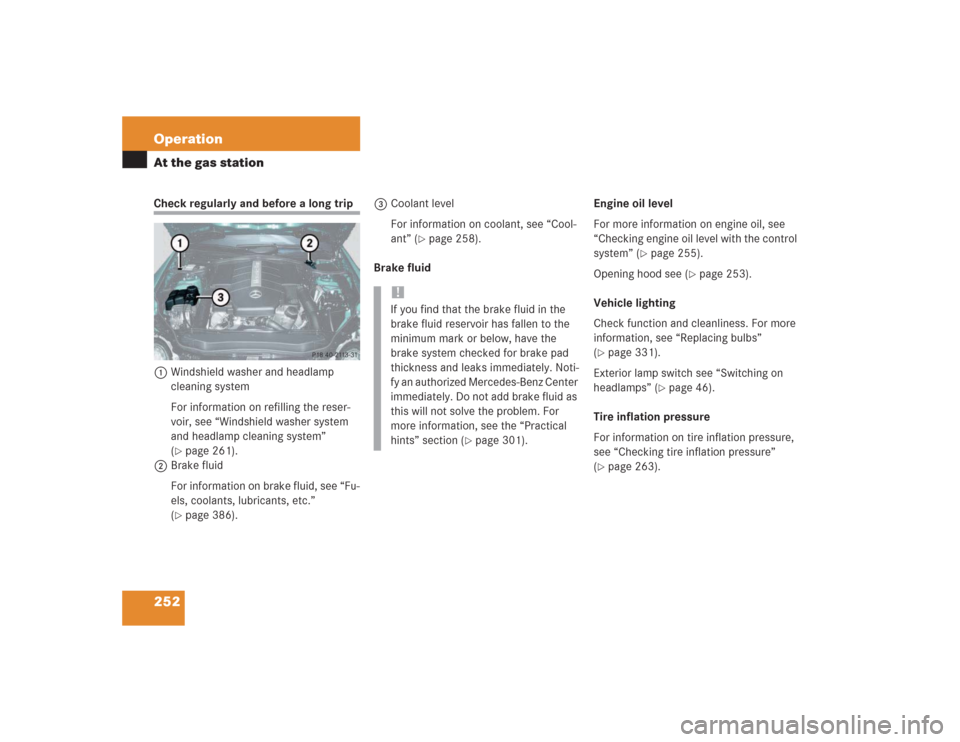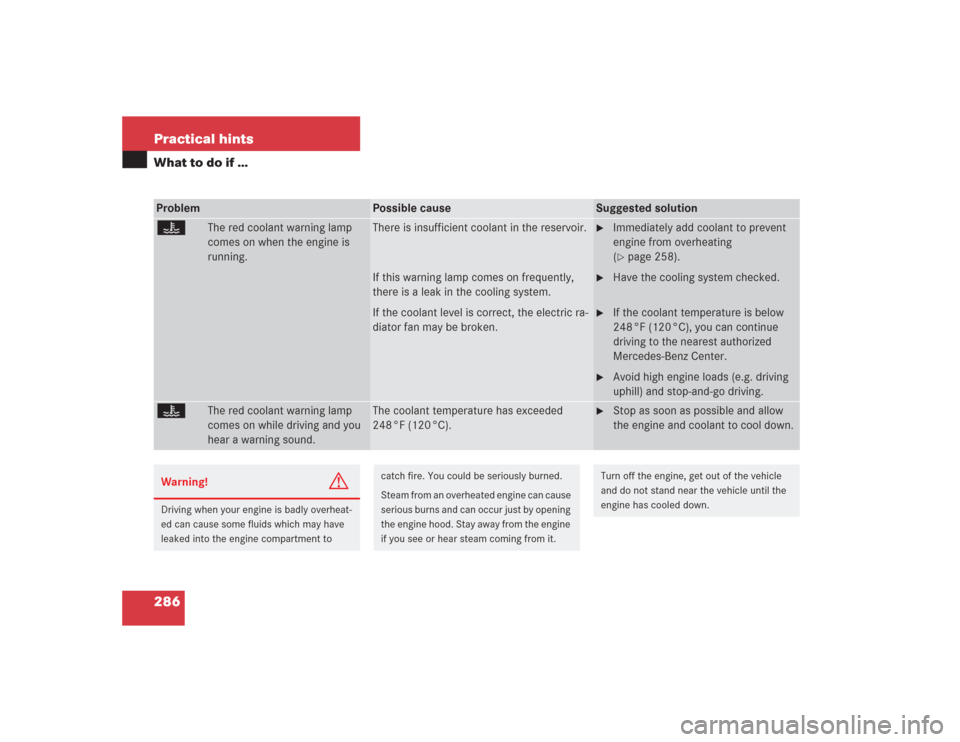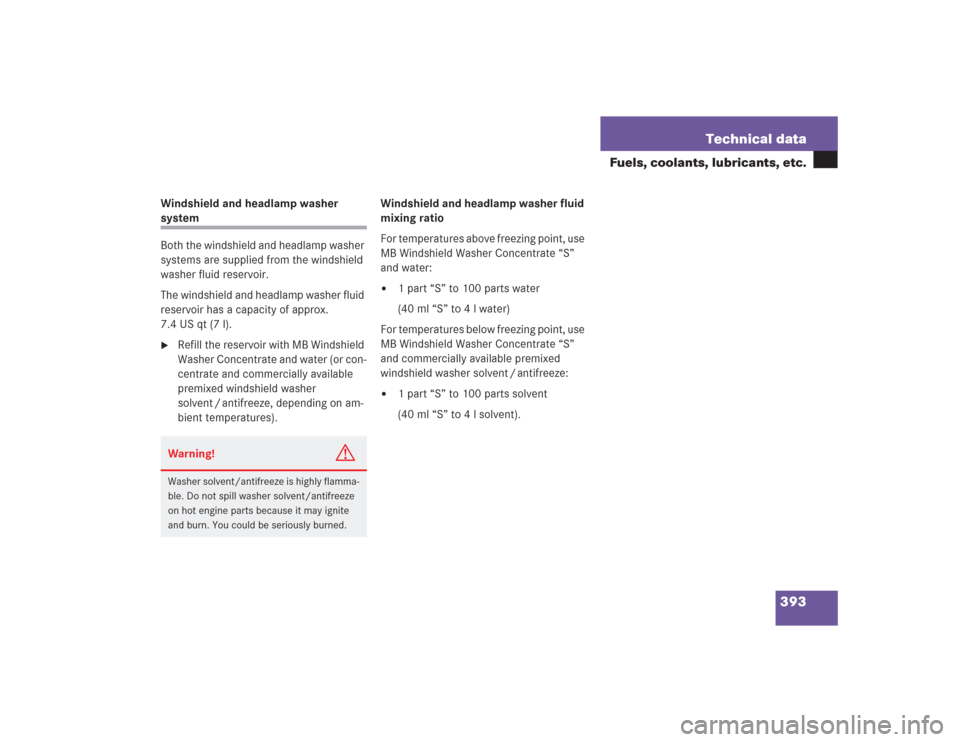Page 253 of 434

252 OperationAt the gas stationCheck regularly and before a long trip
1Windshield washer and headlamp
cleaning system
For information on refilling the reser-
voir, see “Windshield washer system
and headlamp cleaning system”
(
�page 261).
2Brake fluid
For information on brake fluid, see “Fu-
els, coolants, lubricants, etc.”
(�page 386).3Coolant level
For information on coolant, see “Cool-
ant” (
�page 258).
Brake fluidEngine oil level
For more information on engine oil, see
“Checking engine oil level with the control
system” (
�page 255).
Opening hood see (
�page 253).
Vehicle lighting
Check function and cleanliness. For more
information, see “Replacing bulbs”
(
�page 331).
Exterior lamp switch see “Switching on
headlamps” (
�page 46).
Tire inflation pressure
For information on tire inflation pressure,
see “Checking tire inflation pressure”
(
�page 263).
!If you find that the brake fluid in the
brake fluid reservoir has fallen to the
minimum mark or below, have the
brake system checked for brake pad
thickness and leaks immediately. Noti-
fy an authorized Mercedes-Benz Center
immediately. Do not add brake fluid as
this will not solve the problem. For
more information, see the “Practical
hints” section (
�page 301).
Page 259 of 434

258 OperationEngine compartment�
Add engine oil as required. Be careful
not to overfill with oil.
Be careful not to spill any oil when adding.
Avoid environmental damage caused by oil
entering the ground or water.
�
Screw filler cap1 back on filler neck.
For more information on engine oil, see the
“Technical data” section (
�page 386) and
(
�page 388).
Transmission fluid level
The transmission fluid level does not need
to be checked. If you notice transmission
fluid loss or gear shifting malfunctions,
have an authorized Mercedes-Benz Center
check the automatic transmission. Oil level in the ABC system
The oil level in the ABC system does not
need to be checked. If there is visible oil
loss or if malfunction messages appear in
the display, have an authorized
Mercedes-Benz Center check the ABC
system.
Coolant
!Excess oil must be siphoned or drained
off. It could cause damage to the
engine and catalytic converter not
covered by the Mercedes-Benz Limited
Warranty.
Warning!
G
In order to avoid any possibly serious burns:�
Use extreme caution when opening the
hood if there are any signs of steam or
coolant leaking from the cooling system,
or if the coolant temperature gauge indi-
cates that the coolant is overheated.
�
Do not remove pressure cap on coolant
reservoir if engine temperature is above
158°F (70°C). Allow engine to cool
down before removing cap. The coolant
reservoir contains hot fluid and is under
pressure.
�
Using a rag, slowly open the cap approx-
imately
1/2 turn to relieve excess pres-
sure. If opened immediately, scalding
hot fluid and steam will be blown out un-
der pressure.
�
Do not spill antifreeze on hot engine
parts. Antifreeze contains ethylene gly-
col which may burn if it comes into con-
tact with hot engine parts.
��
Page 287 of 434

286 Practical hintsWhat to do if …Problem
Possible cause
Suggested solution
D
The red coolant warning lamp
comes on when the engine is
running.
There is insufficient coolant in the reservoir.
If this warning lamp comes on frequently,
there is a leak in the cooling system.
If the coolant level is correct, the electric ra-
diator fan may be broken.
�
Immediately add coolant to prevent
engine from overheating
(�page 258).
�
Have the cooling system checked.
�
If the coolant temperature is below
248 °F (120 °C), you can continue
driving to the nearest authorized
Mercedes-Benz Center.
�
Avoid high engine loads (e.g. driving
uphill) and stop-and-go driving.
D
The red coolant warning lamp
comes on while driving and you
hear a warning sound.
The coolant temperature has exceeded
248 °F (120 °C).
�
Stop as soon as possible and allow
the engine and coolant to cool down.
Warning!
G
Driving when your engine is badly overheat-
ed can cause some fluids which may have
leaked into the engine compartment to
catch fire. You could be seriously burned.
Steam from an overheated engine can cause
serious burns and can occur just by opening
the engine hood. Stay away from the engine
if you see or hear steam coming from it.
Turn off the engine, get out of the vehicle
and do not stand near the vehicle until the
engine has cooled down.
Page 394 of 434

393 Technical data
Fuels, coolants, lubricants, etc.
Windshield and headlamp washer system
Both the windshield and headlamp washer
systems are supplied from the windshield
washer fluid reservoir.
The windshield and headlamp washer fluid
reservoir has a capacity of approx.
7.4 US qt (7 l).�
Refill the reservoir with MB Windshield
Washer Concentrate and water (or con-
centrate and commercially available
premixed windshield washer
solvent / antifreeze, depending on am-
bient temperatures).Windshield and headlamp washer fluid
mixing ratio
For temperatures above freezing point, use
MB Windshield Washer Concentrate “S”
and water:
�
1 part “S” to 100 parts water
(40 ml “S” to 4 l water)
For temperatures below freezing point, use
MB Windshield Washer Concentrate “S”
and commercially available premixed
windshield washer solvent / antifreeze:
�
1 part “S” to 100 parts solvent
(40 ml “S” to 4 l solvent).
Warning!
G
Washer solvent/antifreeze is highly flamma-
ble. Do not spill washer solvent/antifreeze
on hot engine parts because it may ignite
and burn. You could be seriously burned.